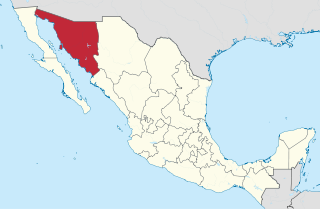External links
- Vance T. Holliday, Guadalupe Sanchez, El Fin del Mundo, Sonora, Mexico argonaut.arizona.edu
El Fin del Mundo (Spanish: 'End of the World') is an ancient Pleistocene site near Pitiquito in northwestern Sonora, Mexico. [1] It features Clovis culture period occupation proposed to date to 13,390 calibrated years Before Present, though this is contested.
El Fin del Mundo is suggested to be one of the oldest Clovis sites in North America, roughly similar chronologically to the Aubrey site in Denton County, Texas, [2] which produced a radiocarbon date that is almost identical. [3]
In 2011, remains of the gomphothere (elephant relative) Cuvieronius dating around 13,390 calibrated years BP were found. This was the first such association found in a northern part of the continent where gomphotheres had been thought to have gone extinct 30,000 years ago. [4] In July 2014, it was announced that the "position and proximity of Clovis weapon fragments relative to the gomphothere bones at the site suggest that humans did in fact kill the two animals there. Of the seven Clovis points found at the site, four were in place among the bones, including one with bone and teeth fragments above and below. The other three points had clearly eroded away from the bone bed and were found scattered nearby." [5] However, a later study considered the dating of both El Fin del Mundo and Aubrey unreliable, so the sites may be younger. [6]
Bones of horse and bison, as well as horse teeth, were also found at the site.

Sonora, officially Estado Libre y Soberano de Sonora, is one of the 31 states which, along with Mexico City, comprise the Federal Entities of Mexico. The state is divided into 72 municipalities; the capital city of which being Hermosillo, located in the center of the state. Other large cities include Ciudad Obregón, Nogales, San Luis Río Colorado, and Navojoa.

Rockwall is a city in Rockwall County, Texas, United States, which is part of the Dallas/Fort Worth metroplex. It is the county seat of Rockwall County. The U.S. Census Bureau estimates that as of the 2020 census, Rockwall's population is 47,251, up from 45,888 in 2019. The name Rockwall is derived from a naturally jointed geological formation, which has the appearance of an artificial wall.

A mastodon is any proboscidean belonging to Mammut the type genus of the extinct family Mammutidae. It, strictly defined, was endemic to North America and lived from the late Miocene to the early Holocene. M. americanum, known as an "American mastodon" or simply "mastodon," had a long and complex paleontological history spanning all the way back to 1705 when the first fossils were uncovered from Claverack, New York in the American colonies. Naturalists struggled to explain the affinities of the proboscidean because of its uniquely shaped molars, which have no modern analogues in terms of large mammals. The American mastodon caught the attention of not only European researchers but also influential Americans before and after the American Revolution. American historians of the 21st century have argued that findings and displays of its fossils had helped to bolster American nationalism and contributed to a greater understanding of extinctions. It is known by many skeletons which are now typically on display in American museums, a trend first started by Charles Willson Peale in 1804.

Clovis points are the characteristically fluted projectile points associated with the New World Clovis culture, a prehistoric Paleo-American culture. They are present in dense concentrations across much of North America and they are largely restricted to the north of South America. There are slight differences in points found in the Eastern United States bringing them to sometimes be called "Clovis-like". Clovis points date to the Early Paleoindian period, with all known points dating from roughly 13,400–12,700 years ago. As an example, Clovis remains at the Murry Springs Site date to around 12,900 calendar years ago. Clovis fluted points are named after the city of Clovis, New Mexico, where examples were first found in 1929 by Ridgely Whiteman.

Clovis culture is a prehistoric Paleoamerican archaeological culture, named for distinct stone and bone tools found in close association with Pleistocene fauna, particularly two Columbian mammoths, at Blackwater Locality No. 1 near Clovis, New Mexico, in 1936 and 1937, though Paleoindian artifacts had been found at the site since the 1920s. It existed from roughly 11,500 to 10,800 BCE near the end of the Last Glacial Period.

Monte Verde is a Paleolithic archaeological site in the Llanquihue Province in southern Chile, located near Puerto Montt, Los Lagos Region. It contains two separate layers, the younger Monte Verde II, dating to 14,500 cal BP, and an older, much more controversial layer suggested to date to 18,500 cal BP. The Monte Verde II site has been considered key evidence showing that the human settlement of the Americas pre-dates the Clovis culture by roughly 1,000 years. This contradicts the previously accepted "Clovis first" model which holds that settlement of the Americas began after 13,500 cal BP. The Monte Verde findings were initially dismissed by most of the scientific community, but the evidence then became more accepted in archaeological circles.

The Folsom tradition is a Paleo-Indian archaeological culture that occupied much of central North America from c. 10800 BCE to c. 10200 BCE. The term was first used in 1927 by Jesse Dade Figgins, director of the Denver Museum of Nature and Science. The discovery by archaeologists of projectile points in association with the bones of extinct Bison antiquus, especially at the Folsom site near Folsom, New Mexico, established much greater antiquity for human residence in the Americas than the previous scholarly opinion that humans in the Americas dated back only 3,000 years. The findings at the Folsom site have been called the "discovery that changed American archaeology."

Cuvieronius is an extinct New World genus of gomphothere which ranged from southern North America to western South America during the Pleistocene epoch. Among the last gomphotheres, it became extinct at the end of the Pleistocene, approximately 12,000 years ago, following the arrival of humans to the Americas.

Notiomastodon is an extinct genus of gomphothere proboscidean, endemic to South America from the Pleistocene to the beginning of the Holocene. Notiomastodon specimens reached a size similar to that of the modern Asian elephant. Like other brevirostrine gomphotheres such as Cuvieronius and Stegomastodon, Notiomastodon had a shortened lower jaw and lacked lower tusks.
Vance T. Holliday is a professor in the School of Anthropology and the department of Geosciences as well as an adjunct professor in the department of Geography at the University of Arizona in Tucson.

This article details the history of Sonora. The Free and Sovereign State of Sonora is one of 31 states that, with the Federal District, comprise the 32 Federal Entities of Mexico. It is divided into 72 municipalities; the capital city is Hermosillo. Sonora is located in Northwest Mexico, bordered by the states of Chihuahua to the east, Baja California to the northwest and Sinaloa to the south. To the north, it shares the U.S.–Mexico border with the states of Arizona and New Mexico, and on the west has a significant share of the coastline of the Gulf of California.
Hell Gap is a deeply stratified archaeological site located in the Great Plains of eastern Wyoming, approximately thirteen miles north of Guernsey, where an abundant amount of Paleoindian and Archaic artifacts have been found and excavated since 1959. This site has had an important impact on North American archaeology because of the large quantity and breadth of prehistoric Paleoindian and Archaic period artifacts and cultures it encompasses. It was designated a National Historic Landmark in 2016.

Pilauco is a paleontological and archaeological site located in the city of Osorno in Southern Chile. The site contains both human made lithic artifacts and megafauna remains–including gomphotheres. All the horizons containing megafauna and evidence of human activity date to the late Pleistocene. The calibrated radiocarbon dates indicate there was human activity in the site between 16,400 and -12,800 cal years B.P.
Rolfe D. Mandel is a Distinguished Professor of archaeology in the Department of Anthropology at the University of Kansas as well as Senior Scientist and Executive Director of the Odyssey Geoarchaeological Research Program at the Kansas Geological Survey. Initially trained as a geographer, he has been a major figure in defining the subdiscipline of geoarchaeology and has spent the last thirty years focusing on the effects of geologic processes on the archaeological record. His primary research interests include geoarchaeology, Quaternary soils, geology, paleoecology, and paleoenvironmental reconstruction in the Great Plains region of the United States as well as the Mediterranean. Over the years, Mandel has participated in numerous research projects and has served as an editor to multiple journals and a book. His work has been key in promoting an interdisciplinary approach in archaeology, geology, and geography.
Tibitó is the second-oldest dated archaeological site on the Altiplano Cundiboyacense, Colombia. The rock shelter is located in the municipality Tocancipá, Cundinamarca, Colombia, in the northern part of the Bogotá savanna. At Tibitó, bone and stone tools and carbon have been found. Bones from Haplomastodon, Cuvieronius, Cerdocyon and white tailed deer from the deepest human trace containing layer of the site is carbon dated to be 11,740 ± 110 years old. The oldest dated sediments are lacustrine clays from an ancient Pleistocene lake.
Checua is a preceramic open area archaeological site in Nemocón, Cundinamarca, Colombia. The site is located 7 kilometres (4.3 mi) north of the town centre. At Checua, thousands of stone and bone tools, stone flakes and human remains have been found, indicating human occupation from around 8500 to 3000 years BP.

The Sabana Formation is a geological formation of the Bogotá savanna, Altiplano Cundiboyacense, Eastern Ranges of the Colombian Andes. The formation consists mainly of shales with at the edges of the Bogotá savanna lignites and sandstones. The Sabana Formation dates to the Quaternary period; Middle to Late Pleistocene epoch, and has a maximum thickness of 320 metres (1,050 ft), varying greatly across the savanna. It is the uppermost formation of the lacustrine and fluvio-glacial sediments of paleolake Humboldt, that existed at the edge of the Eastern Hills until the latest Pleistocene.

The peopling of the Americas began when Paleolithic hunter-gatherers (Paleo-Indians) entered North America from the North Asian Mammoth steppe via the Beringia land bridge, which had formed between northeastern Siberia and western Alaska due to the lowering of sea level during the Last Glacial Maximum. These populations expanded south of the Laurentide Ice Sheet and spread rapidly southward, occupying both North and South America, by 12,000 to 14,000 years ago. The earliest populations in the Americas, before roughly 10,000 years ago, are known as Paleo-Indians. Indigenous peoples of the Americas have been linked to Siberian populations by linguistic factors, the distribution of blood types, and in genetic composition as reflected by molecular data, such as DNA.
The theory known as "Clovis First" was the predominant hypothesis among archaeologists in the second half of the 20th century to explain the peopling of the Americas. According to Clovis First, the people associated with the Clovis culture were the first inhabitants of the Americas. This hypothesis came to be challenged by ongoing studies that suggest pre-Clovis human occupation of the Americas. In 2011, following the excavation of an occupation site at Buttermilk Creek, Texas, a group of scientists identified the existence "of an occupation older than Clovis." At the site in Buttermilk, archaeologists discovered evidence of hunter-gatherer group living and the making of projectile spear points, blades, choppers, and other stone tools. The tools found were made from a local chert and could be dated back to as early as 15,000 years ago.